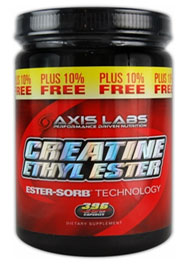Creatine Ethyl Ester Review
What is Creatine Ethyl Ester HCL (CEE)?
 CEE is heavily promoted and hyped as being much better and more potent than Creatine Monohydrate. In simplest terms, it is creatine monohydrate with an ester attached. Some claims include:
CEE is heavily promoted and hyped as being much better and more potent than Creatine Monohydrate. In simplest terms, it is creatine monohydrate with an ester attached. Some claims include:
- Greater solubility in lipids leading to greater absorption rates
- Stronger than other forms of creatine
- Faster results than creatine monohydrate
- Small doses that provide more results
- Directly penetrates the muscle cell
- No need for cycles
Sounds a little too good to be true? We'll find out as we present a list of various studies in this article below. First, we'll discuss what is creatine ethyl ester.
Creatine ethyl ester HCL is a derivative of creatine monohydrate (CM), sold as an athletic performance enhancer and promoted as being better than CM for building muscle and strength. It is an ethyl ester derivative of creatine - the ethyl ester is claimed to promote a much better absorption rate than regular creatine in the body. However these claims are not supported by scientific studies, and in fact some studies have actually found CEE to be less stable than regular CM. Yes, you read that correct - less stable than creatine.1 According to wikipedia, "the compound was developed, patented and licensed through UNeMed, the technology transfer entity of the University of Nebraska Medical Center, and is sold under numerous brand names."
>> Click here for Creatine Ethyl Ester Capsules
Creatine Ethyl Ester Research and Studies
There are far and few studies documenting the true effectiveness of creatine ethyl ester, and even fewer studies backing up the claims made by the promoters of CEE. On the flip side, however, a research done by several British scientists have found that it is unstable, and does not work as well as regular creatine. These researchers presented their findings at the 4th International Society of Sports Nutrition (ISSN) annual meeting in Las Vegas. This study is also one of the first studies to put creatine ethyl-ester to the test.1
Below is a summary of the study.
Creatine ethyl ester rapidly degrades to creatinine in stomach acid
Child R1 and Tallon MJ2
Department of Life Sciences, Kingston University, Penrhyn Rd, Kingston-upon-Thames, United Kingdom. 2University of Northumbria, Sport Sciences, Northumbria University, Northumberland Building, Newcastle upon Tyne, United Kingdom.
Study Summary: Creatine Ethyl Ester is a synthetic creatine widely used by athletes and bodybuilders.
"It comprises of creatine with an ethyl group attached and this molecular configuration is reported to provide several advantages over creatine monohydrate (CM). The Medical Research Institute (CA, USA) claim that the CEE in their product (CE2) provides greater solubility in lipids, leading to improved absorption.
Similarly San (San Corporation, CA, USA) claim that the CEE in their product (San CM2 Alpha) avoids the breakdown of creatine to creatinine in stomach acids. Ultimately it is claimed that CEE products provide greater absorption and efficacy than CM." - quoted from study
The study mentions that these claims are not supported by independent studies, and no comparative data is available for creatine ethyl ester and creatine monohydrate. The study conducted by Child and Tallon was designed to assess the availability of creatine from 3 commercial creatine products during degradation in acidic conditions similar to those that occur in the stomach.
Of these 3 commercial products, 2 contained creatine ethyl ester (San CM2 Alpha, CE2, and a commercially available creatine monohydrate Creapure). An independent lab performed the analysis.
Study Method: Each product was incubated in 900ml of pH1 HCL and samples were taken at 5, 30, and 120 minutes - at which time creatine availability was assessed by immediately assaying for free creatine, creatine ethyl ester, and creatinine (breakdown product of creatine) using HPLC.
At 30 minutes, 73% of the initial CEE was available from CE2, while the CEE of San CM2 Alpha was 62%. Comparatively, more than 99% of the creatine monohydrate remained available. They also found that this reduction in CEE availability was also accompanied by substantial increase in creatinine formation.
After 120 minutes, 72% of the creatine ethyl ester from CE2 was available, but only 11% of the creatine ethyl ester was available from San CM2 Alpha. At this point still 99% of the creatine remained available from the CM product.
Study Conclusion: From their findings, the researchers concluded that the "addition of the ethyl group to creatine actually reduces acid stability and accelerates its breakdown to creatinine. This substantially reduces creatine availability in its esterified form and as a consequence creatines such as San CM2 and CE2 are inferior to CM as a source of free creatine."
What can we, as consumers, get out of all this? First and foremost is the claim that CEE provides several advantages over CM because of its "increased solubility and stability" is false - obviously, all these false claims have been debunked by the study above. CEE is not more stable than regular creatine - in fact, it is less stable. Next, price. Creatine ethyl ester products cost more than regular creatine monohydrate. Next time you're due for a creatine purchase, ask yourself whether you are willing to spend extra money for a product promoted and hyped on false claims, where in fact, it is less stable and breaks down to creatinine more than regular creatine.
Does Creatine Ethyl Ester Work?
Of course it does! Why shouldn't it? After all CEE is just regular creatine with a ethyl ester. Combined with the hype marketing, and large number of users with positive results, there's no reason to say that it does not work. It works. But not as claimed in much of the promotional material you read about. There are plenty of anecdotal evidence that it works - but how much of this is because of the placebo effect? I wonder...
However, the bottom line of it all is that creatine ethyl ester is not better than creatine monohydrate, as the supplement manufacturers would have you believe, and you'll probably be better off spending your hard earned money on some regular creatine monohydrate.
>> Click here for Creatine Ethyl Ester Capsules
1. Child R1 and Tallon MJ2. Creatine ethyl ester rapidly degrades to creatinine in stomach acid. Department of Life Sciences, Kingston University, Penrhyn Rd, Kingston-upon-Thames, United Kingdom. 2University of Northumbria, Sport Sciences, Northumbria University, Northumberland Building, Newcastle upon Tyne, United Kingdom.
 CEE is heavily promoted and hyped as being much better and more potent than Creatine Monohydrate. In simplest terms, it is creatine monohydrate with an ester attached. Some claims include:
CEE is heavily promoted and hyped as being much better and more potent than Creatine Monohydrate. In simplest terms, it is creatine monohydrate with an ester attached. Some claims include:
